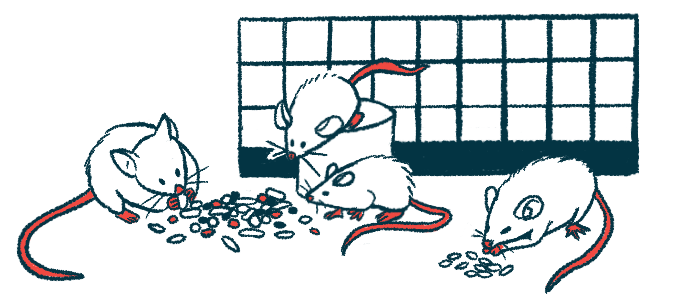Approved Medication Terazosin May Be ‘Exciting’ New ALS Treatment
Blood pressure medicine prevented motor neuron death in ALS animal models

Treatment with terazosin, a medication approved to treat high blood pressure and enlarged prostate, was found to protect motor neurons and extend survival in animal models of amyotrophic lateral sclerosis (ALS) in a new study.
“Our work shows that terazosin is protective of motor neuron cell death in multiple models of [ALS], making it an exciting new potential therapy,” Helena Chaytow, PhD, a senior postdoctoral researcher at the University of Edinburgh and first author of the study, said in a university press release.
“The benefit of working with terazosin is that it is already prescribed for a different health condition, so we know that it is safe for humans and could quickly move to the clinic,” Chaytow said.
Scientists at the Universities of Edinburgh and Oxford are now conducting a feasibility study to determine if terazosin treatment slows disease progression in 50 people with ALS.
The study, “Targeting phosphoglycerate kinase 1 with terazosin improves motor neuron phenotypes in multiple models of amyotrophic lateral sclerosis,” was published in eBioMedicine.
ALS is the most common form of motor neuron disease (MND), a group of conditions characterized by the abnormal function and death of motor neurons. These specialized nerve cells control movement, and their loss leaves the brain unable to move muscles or control muscle movement.
The biological mechanisms that drive motor neuron death in ALS and other MNDs are incompletely understood, but a large body of research has suggested that energy production is abnormal in ALS, which may contribute to problems with neurons.
Cells in the body generate energy by breaking down the simple sugar molecule glucose, in a process called glycolysis. One of the key enzymes needed for glycolysis, phosphoglycerate kinase 1 or PGK1, is sometimes found at lower levels in people with MNDs.
Thus, boosting this protein’s activity may help improve energy generation in motor neurons.
Investigating motor neurons in animal models
In an initial battery of experiments, the researchers tested whether increasing PGK1 levels via genetic engineering could prevent motor neuron dysfunction in two zebrafish models of ALS. These models either produced an abnormal TDP-43 protein, which forms toxic clumps in nerve cells in most ALS cases, or lacked the C9orf72 gene.
“Zebrafish are a useful vertebrate model for genetic manipulation due to their translucent bodies during the first few days post-fertilisation, large clutch size allowing for within-clutch controls, and external egg-laying allowing for injections of genetic constructs at the single cell stage,” the team noted.
Results showed that increasing PGK1 levels normalized motor neuron development and improved motor function in both models.
The team then tested whether the same effect could be achieved with terazosin, given previous research that established that this medication has PGK1-activating properties.
Terazosin treatment in fact improved neuron health in both models similarly to increasing PGK1 with genetic engineering. Moreover, it significantly improved motor function in the TDP-43 model, although not in the other.
“Thus, targeting PGK1, either genetically through overexpression or pharmacologically using terazosin, can rescue key motor neuron phenotypes [traits] in ALS zebrafish models,” the scientists concluded.
Testing terazosin in the lab
To learn more, the researchers next tested terazosin in a mouse model of fast-progressing ALS, in which the mice were engineered to produce high levels of the human TDP-43 protein. Treatment with terazosin led to a small but statistically significant improvement in survival outcomes, from a median survival time of 21 days to 22 days.
Clinical scores — based on assessments of limb weakness and paralysis in the mice — also were significantly improved with terazosin treatment. In addition, mice treated with terazosin had 40% more motor neurons in their spinal cords on day 19, implying that terazosin improved motor neuron survival.
“Even in a very severe mouse model of TDP-43 overexpression, treatment with terazosin is neuroprotective with significant improvements in both survival and clinical phenotypes resulting from protection of motor neuron death,” the researchers concluded.
Further experiments done in cell models showed that terazosin treatment boosted glycolysis as expected, and also normalized the activity of cellular structures called stress granules. Such granules are commonly the precursors of the toxic protein clumps found in ALS cells.
These findings led the team to “propose terazosin as a new therapy to be repurposed for ALS, with the possibility of helping a wide range of motor neuron disease patients if translated to the clinic.”
A noted limitation of the study is that all of the models used are for genetic forms of ALS. However, given that terazosin would not target the underlying disease cause, the researchers postulated that it likely would be beneficial in sporadic ALS as well.
This work was funded in part by MND Scotland and the My Name’5 Doddie Foundation, two leading ALS advocacy organizations in Scotland.
“After testing in a range of models, the results of this study show us that terazosin, a drug currently used to treat enlarged prostates and high blood pressure, may be able to protect motor neurons,” said Jane Haley, PhD, director of research at MND Scotland.
“We are delighted that, as a result, the drug will move to a feasibility study in Oxford, involving people living with MND,” Haley said, adding, “This is a wonderful example of researchers, clinicians and MND charities working together to try and speed up the search for new treatments” for ALS and other related disorders.








